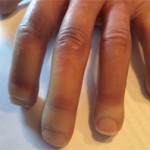“Blood pressure?” Dr. Medsger interjected. “We begin with the vital signs here.” He paused. “They’re important.”
I looked down at my notes. “BP 138/86, resting heart rate: 96/minute. They’re up a bit, but she’s anxious and in pain. The fingertip ulcers look horrendous.” Dr. Medsger raised an eyebrow. I went on. “Her husband recorded a few recent blood pressures. They were mostly normal, so today’s reading might be a red herring, a blip.”
“Or?” Dr. Medsger locked onto my eyes.
I blinked as I silently reviewed the differential diagnosis of hypertension, including rarer triggers, such as renal artery hypertension, pheochromocytoma, Conn’s syndrome and … “scleroderma renal crisis?” I asked.
“Could be.” Dr. Medsger replied.
“But it’s pretty borderline, isn’t it? In my practice I wouldn’t even consider treating her with meds unless it was consistently over 140/90.”
Dr. Medsger reached into his briefcase and pulled out an article from the Journal of Medicine titled “Hypertension and renal failure (scleroderma renal crisis) in progressive systemic sclerosis: Review of a 25-year experience with 68 cases,” and plunked it on the table.1 I wondered if he was going to ask me to go home to Maine. He stood and buttoned his white coat. “Anything else?”
“Her lungs. Inspiratory crackles in both bases,” I said.
“Anything else?”
I hesitated. “Her heart sounds were unusual. The second heart sound at the left sternal border was increased. There might have been a soft diastolic murmur, same location.”
“And what do you think that means?”
“She could have pulmonary hypertension,” I replied. My mind was sifting through and retrieving information that had been lightly used. Even though I had never diagnosed a patient with pulmonary hypertension, I believed I was correct. It made sense. It was the right setting.
“Good. Let’s take a look.”
In the Exam Room
Dr. Medsger lightly shook hands with the Induras and asked Dr. Indura if he could see a picture of her two children. A crooked smile radiated into her cheeks. She opened up her purse with the better of her two hands and retrieved a photo of the girls in ice skates flanking their father.
“Beautiful girls. Ice skating in Albuquerque—who would guess?” Dr. Medsger handed back the picture and wrapped the blood pressure cuff around Dr. Indura’s upper arm. After pumping up the cuff, he slowly released the pressure and wrote down the BP on a scrap of paper. “138/90. We’ll take it one more time in a few minutes. Dr. Radis, can you ask Gail at the desk if she can have lab come down to draw some blood?”



